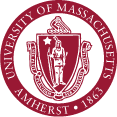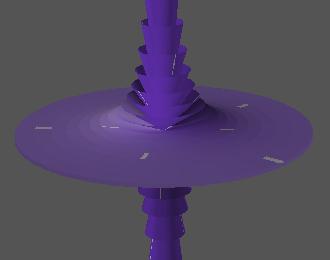NOTE Here are the schedules for TWIGS
Fall 2002, TWIGS Spring 2003, TWIGS Fall 2003, TWIGS Spring 2004, and TWIGS Fall 2004.
Spring Schedule
| |  |
25 February |
Michael Bush,
UMass Amherst |
| |
12:15-1:15
|
What is a profinite group?
|
| |
|
| |  |
4 March |
Tom Weston,
UMass Amherst |
| |
12:15-1:15
|
What is a p-adic L-function?
|
| |
|
| |  |
11 March |
Farshid Hajir,
UMass Amherst |
| |
12:15-1:15
|
SPECIAL STUMP THE CHUMP EDITION OF TWIGS
|
| |
|
| |  |
25 March |
Farshid Hajir,
UMass Amherst |
| |
12:15-1:15
|
What is the Mahler measure of a polynomial?
|
| |
|
| |  |
31 March |
Rob Benedetto,
Amherst College |
| |
1:00-2:00
|
What is an affine scheme?
[RESCHEDULED FOR APRIL 7 DUE TO AQAD]
|
| |
|
| |  |
7 April |
Rob Benedetto,
Amherst College |
| |
1:00-2:00
|
What is an affine scheme?
|
| |
|
| |  |
15 April |
Franz Pedit,
UMass Amherst |
| |
12:15-1:15
|
What is GANG?
|
| |
|
| |  |
22 April |
Tom Braden,
UMass Amherst |
| |
12:15-1:15
|
What is a characteristic class?
|
| |
|
| |  |
29 April |
John Staudenmayer, UMass Amherst
|
| |
12:15-1:15
|
What is a Support Vector Machine?
|
| |
|
| |  |
6 May |
Keith Conrad,
UCONN |
| |
12:15-1:15
|
What is infinite Galois theory?
|
| |
|
Abstracts
25 February
Michael Bush, UMass Amherst
What is a profinite group?
Abstract
Profinite groups are topological groups that often
arise in mathematics by providing a convenient way to package together
infinite families of finite groups into a single object. We will give
two definitions of such groups (one topological, the other algebraic)
and explain why they are equivalent. We will then look at several
important examples that arise in algebra and number theory. This talk
should be accessible to anyone who knows the basic facts about finite
groups and topological spaces.
4 March
Tom Weston, UMass Amherst
What is a p-adic L-function?
Abstract
FUN WITH BERNOULLI NUMBERS! First we'll meet or
become reaquainted with
p-adic numbers, then we'll meet or become recquainted with L-functions,
and finally we'll introduce the two of them to each other to make
p-adic L-functions.
11 March
Farshid Hajir, UMass Amherst
SPECIAL STUMP THE CHUMP EDITION
Abstract
This is the first installment of the Stump the Chump
Edition of TWIGS, where you get to ask Farshid to define mathematical
objects on the spot (with no outside sources). You can also ask about
major theorems/conjectures if you wish. Here is your chance to put a
professor through the ringer! Come find out how little Farshid knows!
(It's bound to make you feel good). [Questions I was asked: "What is
quantum ergodicity?" (the chump was stumped). "What is a moduli
space?" (isomorphism classes of geometric objects often natually
become points of another geometric objec; I described how upper-half
plane modulo SL(2,Z) classifies complex tori).]
TOP
25 March
Farshid Hajir, UMass Amherst
What is the Mahler measure of a polynomial?
Abstract
The Mahler measure of a monic one-variable polynomial with complex
coefficients, so-called because it was first considered by
Lehmer, is the product of the absolute values of its roots
outside the unit circle. That takes care of the "What is...?"
part. The rest of the talk will concentrate on the "What
is ... good for?!" part. In particular, I'll discuss a
theorem of Kronecker and an intriguing question of Lehmer
about the Mahler measure of polynomials with integer
coefficients and its connections to deep questions in number
theory.
TOP
31 March
Rob Benedetto, Amherst College
What is an affine scheme?
Abstract
There is an important and very fruitful
correspondence between objects in algebraic geometry and commutative
algebra according to which the elements of a (commutative) ring "act
as" functions on an associated geometric object. The geometric object
in question is an affine scheme. [Now, if we could just take derivatives
of those functions ... -- The Editors.]
15 April
Franz Pedit, UMass Amherst
What Is GANG?
Abstract
The Center for Geometry, Analysis, Numerics & Graphics (GANG) is an
interdisciplinary Differential Geometry research team in the Dept of
Mathematics & Statistics at the University of Massachusetts,
Amherst. This talk will give an overview of some mathematical problems
of interest to current members of GANG.
22 April
Tom Braden, UMass Amherst
What is a characteristic class?
Abstract
Vector bundles are important tools in many areas of geometry. A
vector bundle over a space X looks locally like a product of X with a
vector space, but it need not be a product globally. Characteristic
classes provide one way to measure the extent to which a bundle is
"twisted". I will introduce these ideas using simple examples and not
too much heavy machinery.
29 April
John Staudenmayer, UMass Amherst
What is a Support Vector Machine?
Abstract
Suppose one observes pairs (x_i,y_i) i=1,...,n, where x_i is a vector and
y_i is a scalar that has m possible values (y_i is a categorical
response). Those data can be used to develop a classification model that
can be applied to a new x_j to predict the value of the unobserved
associated y_j. A support vector machine is a bad name (in my opinion) for
a general tool that can be used as a classification model. We'll describe
support vector machines in some detail in this talk. Possible highlights:
separating hyperplane, kernel function, quadratic program, discriminant
analysis, logistic regression.
6 May
Keith Conrad, UConn
What is infinite Galois theory?
Abstract
When a finite extension of fields is a Galois extension, there is a
one-to-one correspondence between intermediate fields and subgroups of
the Galois group. The concept of Galois extension can be generalized
to field extensions of infinite degree, but the usual Galois
correspondence breaks down: different subgroups of the (infinite)
Galois group can correspond to the same intermediate field. There is
a way to restore the classical Galois correspondence for infinite
extensions, by introducing a suitable topology on the Galois group and
using topological notions.
The picture above was created by
Paul Gunnells.
It visualizes the natural action of the group
of units of a complex cubic field on 3-space.
Consult
Paul for more details.
Last modified: Feb 2004 by
Farshid Hajir


 The Seminar meets on most Fridays, 12:15-1:15
in 1634 LGRT.
The Seminar meets on most Fridays, 12:15-1:15
in 1634 LGRT.
 Driving Directions and
Campus Maps
Driving Directions and
Campus Maps
 Overview of the Seminar
Overview of the Seminar
